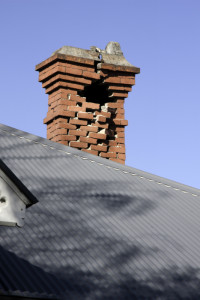While our fireplaces keep the inside of our homes warm and welcoming during the winter, the weather and temperatures outside can cause our chimneys to deteriorate. The freeze thaw cycle can cause significant chimney damage in as little as one season; despite this, few homeowners understand how it can harm there chimneys. The following is an explanation of what the freeze thaw cycle is, how to identify it, and how to keep it from damaging your chimney.
What is the freeze thaw cycle?
To understand the freeze thaw cycle, it is important to know that brick is a naturally porous substance. Because of this, all masonry can absorb small amounts of water at any time; however, the porous nature also allows gasses and smoke to pass through the brick, making masonry an ideal choice for chimney construction.
While regular, undamaged brick may only absorb a minute amount of water at any one time, bricks with cracks, holes, or other areas of damage can absorb water in much higher quantities. As the temperature drops, this water freezes and as it freezes, expands. When the now-ice melts, leaves behind bigger areas of damage. This, in turn, allows more water in; this repeated damage is what is known as the freeze thaw cycle. While water damage can happen year round, the freeze thaw cycle typically only occurs in the winter when the outside temperatures drop below freezing.
The freeze thaw cycle can start off extremely small, expanding virtually imperceptible cracks or holes. However, the problem will only continue to get worse and worse over time; as the areas of damage become larger, the deterioration happens at a much faster rate. Because of this, chimneys can undergo serious damage in as little as a single winter season.
How masonry gets damaged
Cracks or holes in the masonry can be the foothold for the beginnings of the freeze thaw cycle. The following are two common causes of masonry damage that can leave your chimney susceptible to the freeze thaw cycle.
- Pressure washing: While using a powered hose or pressure washer might seem like a cheap and easy way to clean your masonry surfaces, it can actually cause cracks, holes, and chips to form in the soft surface of the brick. Instead of using a pressure washer, try a mixture of bleach and water – and elbow grease – to remove moss or other stains.
- Spalling: Spalling is hard to miss; it occurs when water damage has caused the brick to crack or fall away from the chimney. Masonry with spalling damage is particularly susceptible to additional water damage, as are the surrounding bricks.
How to prevent masonry damage
While regular chimney maintenance can help you identify signs of the freeze thaw cycle as soon as it begins to happen, many homeowners are looking for preventative measures that can protect their chimneys against water damage. Having a professional grade waterproof sealant applied to your chimney can help keep water out while allowing the bricks to remain porous. Likewise, waterproofing can help to significantly slow if not stop any existing water damage.
This winter, don’t let the freeze thaw cycle cause damage to your chimney. Contact Mason’s Chimney Service today for more information on how to protect your chimney from water damage during cold weather.

